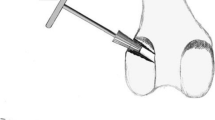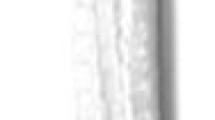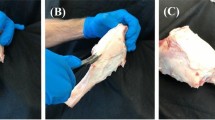Abstract
In this experimental study, the authors evaluated the biomechanical properties of the femoral press-fit graft fixation technique in ACL reconstruction. 20 fresh frozen distal femurs, patellae and patellar ligaments were used from 10 cadaver specimens. Three bone-patellar tendon grafts of 10 mm width were prepared from each sample; altogether 60 bone-patellar tendon grafts were prepared for the experiment. Three 9 mm wide tunnels were drilled in each distal femur at different angles (0, 15, 30, 45, and 60 degrees). This means that 60 tunnels were drilled into the 20 femurs, 12 at each angle. The trapezoid bone blocks were impacted into the holes. The primary stability and stiffness of this press-fit fixation method were measured with a Zwick 020 computer-controlled testing device using maximum-failure tensile-strength tests. The ultimate tensile strength was the greatest at 45 degrees (534±20 N, range 507–554), with 118±10 N/mm (range 99–126) stiffness, followed by 485±35 N (range 416–510) with 122±13 N/mm (range 104–136) stiffness at 30 degrees, 353±18 N (range 320–371) with 113±13 N/mm (range 83–124) stiffness at 15 degrees, and 312±30 N (range 261–343) with 89±14 N/mm (ranged:68–103) stiffness at 0 degrees. In the cases of 0, 15, 30 and 45 degrees the bone blocks were pulled out of the drilled holes, but at 60 degrees rupture of the patellar tendon or breakage of the bone block occurred more frequently. It can be seen that the ultimate tensile strength increased with the angle between the loading direction and the bone block. When compared to data in the literature, these data showed similar and satisfying biomechanical properties of femoral press-fit fixation. Because of the known advantages of an implantation-free fixation technique, the femoral press-fit fixation technique can be a good alternative in ACL surgery. These results provide the basis for future studies involving the postoperative healing process of this femoral press-fit fixation technique in porcine knees.


Similar content being viewed by others
References
Amis AA (1988) The strength of artificial ligament anchorages: a comparison experimental study. J Bone Joint Surg Br 70:397–403
Bach BR Jr (1989) Potential pitfalls of Kurosaka screw interference fixation for ACL surgery. Am J Knee Surg 2:76–82
Boszotta H (1997) Arthroskopische femorale Press-fit-Fixation des Lig.-patellae-Transplantats beim Ersatz des vorderen Kreuzbands. Arthroskopie 10:126–132
Boszotta H (1997) Arthroscopic anterior cruciate ligament reconstruction using a patellar tendon graft in press-fit technique: surgical technique and follow-up. Arthroscopy 13:332–339
Brand J Jr, Weiler A, Caborn DN, Brown CH Jr, Johnson DL (2000) Graft fixation in cruciate ligament reconstruction. Review. Am J Sports Med 28:761–774
Brown CH Jr, Hecker AT, Hipp JA, Myers ER, Hayes WC (1993) The biomechanics of interference screw fixation of patellar tendon anterior cruciate ligament grafts. Am J Sports Med 21:880–886
Brown CH Jr, Carson EW (1999) Revision anterior cruciate ligament surgery. Clin Sports Med 18:109–171
Brown GA, Pena F, Grontvedt T, Labadie D, Engebretsen L (1996) Fixation strength of interference screw fixation in bovine, young human, and elderly human cadaver knees: influence of insertion torque, tunnel-bone block gap, and interference. Knee Surg Sports Traumatol Arthrosc 3:238–244
Bryan JM, Bach Jr, BR, Bush-Joseph CA, Fisher IM, Hsu KY (1996) Comparison of “inside-out” and “outside-in” interference-screw fixation for anterior cruciate ligament surgery in a bovine knee. Arthroscopy 12:76–81
Dworsky BD, Jewell FB, Bach BR Jr (1996) Interference screw divergence in endoscopic anterior cruciate ligament reconstruction. Arthroscopy 12:45–49
Georgoulis AD, Papageorgiou CD, Makris CA, Moebius UG, Soucacos PN (1997) Anterior cruciate ligament reconstruction with the press-fit technique. 2–5 years follow-up of 42 patients. Acta Orthop Scand Suppl 275:42-45
Gobbi A, Diara A, Mahajan S, Zanazzo M, Tuy B (2002) Patellar tendon anterior cruciate ligament reconstruction with conical press-fit femoral fixation: 5-year results in athletes population. Knee Surg Sports Traumatol Arthrosc 10:73-79
Grana WA, Egle DM, Mahnken R, Goodhart CW (1994) An analysis of autograft fixation after anterior cruciate ligament reconstruction in a rabbit model. Am J Sports Med 22:344–351
Hertel P (1990) A new technique for ACL replacement. Fourth Congress of the ESKA Stockholm, Sweden
Hertel P, Bernard M (1994) Vordere Kreuzbandersatzplastik – Vorteile einer metallfreien offenen Press-Fit Operationstechnik (Einschnittechnik) gegenüber einer arthroskopischen Unitunnel-Technik. In: Kohn D, Wirth CJ (eds) Arthroskopische versus offene Operationen. Enke, Stuttgart
Honl M, Carrero V, Hille E, Schneider E, Morlock MM (2002) Bone-patellar tendon-bone grafts for anterior cruciate ligament reconstruction: an in vitro comparison of mechanical behavior under failure tensile loading and cyclic submaximal tensile loading. Am J Sports Med 30:549–557
Hulstyn M, Fadale PD, Abate J, Walsh WR (1993) Biomechanical evaluation of interference screw fixation in a bovine patellar bone-tendon-bone autograft complex for anterior cruciate ligament reconstruction. Arthroscopy 9:417–424
Jomha NM, Raso VJ, Leung P (1993) Effect of varying angles on the pullout strength of interference screw fixation. Arthroscopy 9:580–583
Kohn D, Rose C (1994): Primary stability of interference screw fixation influence of screw diameter and insertion torque. Am J Sports Med 22:334–338
Kühne JH, Fottner M, Plitz W (1999) Primärstabilität einer implantatfreien Verankerung des Lig.-patellae-Transplantats beim vorderen Kreuzbandersatz. Unfallchirurg 102:791–796
Kurosaka M, Yoshiya S, Andrish JT (1987) A biomechanical comparison of different surgical techniques of graft fixation in anterior cruciate ligament reconstruction. Am J Sports Med 15:225–229
Lee MC, Jo H, Bae T-S, Jang JD, Seong SC (2003) Analysis of initial fixation strength of press-fit fixation technique in anterior cruciate ligament reconstruction. Knee Surg Sports Traumatol Arthrosc 11:91–98
Lemos MJ, Albert J, Simon T, Jackson DW (1993) Radiographic analysis of femoral interference screw placement during ACL reconstruction: endoscopic versus open technique. Arthroscopy 9:154–158
Lemos MJ, Jackson DW, Lee TQ, Simon T (1995) Assessment of initial fixation of endoscopic interference screws with divergent and parallel placement. Arthroscopy 11:37–41
Matthews LS, Soffer SR (1989) Pitfalls in the use of interference screws for anterior cruciate ligament reconstruction: brief report. Arthroscopy 5:225–226
Matthews LS, Lawrence SJ, Yahiro MA, Sinclair MR (1993) Fixation strength of patellar tendon-bone grafts. Arthroscopy 9:76–81
Markolf KL, Gorek JF, Kabo JM, Shapiro MS. (1990) Direct measurement of resultant forces in the anterior cruciate ligament. An in vitro study performed with a new experimental technique. J Bone Joint Surg Am 72:557–567
McFarland EG, Morrey BF, An KN, Wood MB (1986) The relationship of vascularity and water content to tensile strength in a patellar tendon replacement of the anterior cruciate in dogs. Am J Sports Med 14:436–448
Noyes FR, Grood ES (1976) The strength of the anterior cruciate ligament in humans and rhesus monkeys. Age-related and species-related changes. J Bone Joint Surg Am 58:1074–1082
Pässler HH (1997) Neue Operationsmethode zur anatomiegerechten Rekonstruktion des vorderen Kreuzbands mit der Patellarsehne. Arthroskopie 10:250–255
Rowden NJ, Sher D, Rogers GJ, Schindhelm K (1997) Anterior cruciate ligament graft fixation. Initial comparison of patellar tendon and semitendinosus autografts in young fresh cadavers. Am J Sports Med 25:472–478
Rupp S, Krauss PW, Fritsch EW (1997) Fixation strength of a biodegradable interference screw and a press-fit technique in anterior cruciate ligament reconstruction with a BPTB graft. Arthroscopy 13:61–65
Shapiro JD, Cohn BT, Jackson DW, Postak PD, Parker RD, Greenwald AS (1992) The biomechanical effects of geometric configuration of bone-tendon-bone autografts in anterior cruciate ligament reconstruction. Arthroscopy 8:453–458
Shapiro JD, Jackson DW, Aberman HM, Lee TQ, Simon TM (1995) Comparison of pullout strength for seven- and nine-millimeter diameter interference screw size as used in anterior cruciate ligament reconstruction. Arthroscopy 11:596–599
Shelbourne KD, Nitz P (1990) Accelerated rehabilitation after anterior cruciate ligament reconstruction. Am J Sports Med 18:292–299
Singhatat W, Lawhorn KW, Howell SM, Hull ML (2002) How four weeks of implantation affect the strength and stiffness of a tendon graft in a bone tunnel: a study of two fixation devices in an extraarticular model in ovine. Am J Sports Med 30:506–513
Tomita F, Yasuda K, Mikami S, Sakai T, Yamazaki S, Tohyama H (2001) Comparisons of intraosseous graft healing between the doubled flexor tendon graft and the bone-patellar tendon-bone graft in anterior cruciate ligament reconstruction. Arthroscopy 17:461–476
Woo SL-Y, Hollis M, Adams DJ, Lyon RM, Takai S (1991) Tensile properties of the human femur–anterior cruciate ligament–tibia complex. The effects of specimen age and orientation. Am J Sports Med 19:217–225
Author information
Authors and Affiliations
Corresponding author
Rights and permissions
About this article
Cite this article
Pavlik, A., Hidas, P., Czigány, T. et al. Biomechanical evaluation of press-fit femoral fixation technique in ACL reconstruction. Knee Surg Sports Traumatol Arthrosc 12, 528–533 (2004). https://doi.org/10.1007/s00167-003-0452-x
Received:
Accepted:
Published:
Issue Date:
DOI: https://doi.org/10.1007/s00167-003-0452-x




